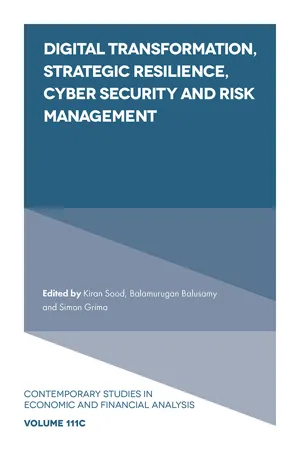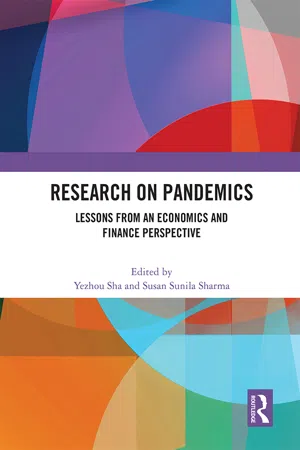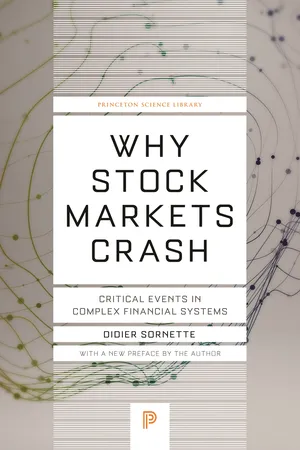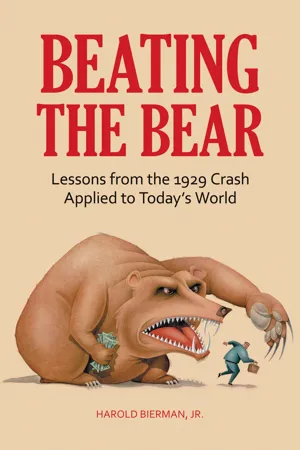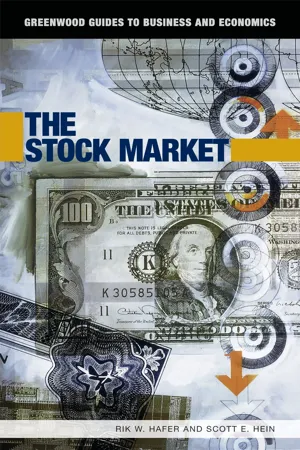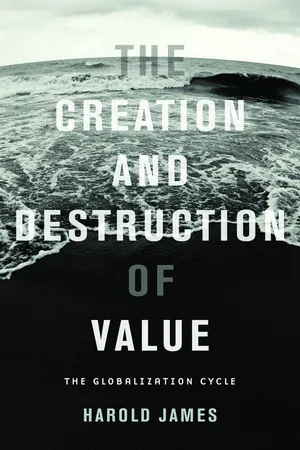Economics
2020 Stock Market Crash
The 2020 stock market crash refers to the sharp and rapid decline in global stock markets in February and March 2020, largely triggered by the COVID-19 pandemic. This crash led to significant volatility, widespread investor panic, and a major economic downturn. Governments and central banks implemented various measures to stabilize the markets and support the economy during this period.
Written by Perlego with AI-assistance
Related key terms
1 of 5
7 Key excerpts on "2020 Stock Market Crash"
- Kiran Sood, Balamurugan Balusamy, Simon Grima, Kiran Sood, Balamurugan Balusamy, Simon Grima, Balamurugan Baluswamy(Authors)
- 2023(Publication Date)
- Emerald Publishing Limited(Publisher)
3. PROBLEM STATEMENTThe stock market is viewed to be one of the economic barometers of a country. Given its importance, many participants invest their hard-earned money in expectation of a positive return. So, it is necessary to understand the market dynamics. The pandemic had a drastic effect on all sectors, and stock markets were no exception. The volatility and the performance of stock markets were disturbed, creating turbulence. From the last few months, it is evident that the stock markets have reacted adversely to COVID-19. This is mainly due to investors’ beliefs, government policies, the shutdown of companies, and the imposed restrictions. This built interest to understand the magnitude of impact on the stock market in emerging economic use, especially the BRIC nations. But the studies reviewed have not examined the effect of COVID-19 on the stock markets of BRIC countries. Furthermore, the studies have also not discussed the magnitude of the effect of COVID-19 on the stock market at different waves. The studies have considered the impact of COVID-19 for a specified short period, whose results differ in the long run. This study develops a model to ascertain the impact of COVID-19 on stock market indices and forecast the effect of such unforeseen events in the future. This study aims at striking a relationship between COVID-19 positivity and death rate and the stock market indices. So that future researchers can use this as a foundation for further exploration.4. RESEARCH QUESTIONS
- eBook - ePub
Research on Pandemics
Lessons from an Economics and Finance Perspective
- Yezhou Sha, Susan Sunila Sharma(Authors)
- 2021(Publication Date)
- Routledge(Publisher)
The year 2020 is destined to be recorded in history because of extraordinary turn of events. The outbreak and spread of novel coronavirus (COVID-19) disease across the world have seriously affected people’s production and life in general. Economies around the world are presently facing severe challenges due to the COVID-19 outbreak. According to real-time statistical data released by Johns Hopkins University, as of June 5, 2020, globally there have been 6,601,349 diagnosed cases of and 389,620 deaths from COVID-19. There are already clear signs of a recession in the global economy. In the “Global Economic Outlook” report in April 2020, the International Monetary Fund predicted that global gross domestic product (GDP) would fall by 3% throughout the year, while the World Trade Organization predicted that global trade could decline by as much as 32% in 2020. The impact of COVID-19 on the economy is not a cyclical fluctuation in the traditional economic development process. The short-term disasters generated by the pandemic also surpass any endogenous and extreme events in the past. Assessing and understanding the economic impact of COVID-19 has become an important issue. The purpose of this article is to evaluate the impact of COVID-19 on stock prices.The traditional economic and financial theory holds that stock prices are mainly affected by market and firm characteristic-based factors. Companies in the same industry face the same regulatory and policy environment and similar macroeconomic conditions. When faced with changes in the economic environment, the operating conditions of companies in the same industry are highly correlated (Moskowitz and Grinblatt 1999 ). According to the theory of behavioral finance, in addition to the basic value of stocks, emergencies will have an impact on investors’ psychological and behavioral factors, which in turn will have an important impact on stock prices. Lee and Jiang (2002 ) believe that investor optimism will reduce earnings volatility, while investor pessimism will increase earnings volatility. Therefore, the outbreak of COVID-19 will have an impact on the economic environment, which will affect investor sentiment, causing stock price changes.The COVID-19 pandemic, as a public health emergency, is not only causing human infections and deaths, it is also disrupting the stock market. According to the China Health Committee, as of June 5th, the cumulative number of COVID-19 diagnoses in China was 84,617, with a cumulative death of 4,645. As the first country to respond to COVID-19, China made great efforts to resume work and production. When COVID-19 was declared, the Chinese government called for greater macro-policy adjustments and an active fiscal and taxation policy (Li, Zhang, and Zhao 2020 ). Yang, Chen, and Zhang (2020 - Murat Demir, Ali Burak AKSUNGUR, Murat Demir, Ali Burak AKSUNGUR(Authors)
- 2021(Publication Date)
- Peter Lang Group(Publisher)
Following the first deaths relating to the virus in the US, the US and UK stock markets suffered their biggest lost in his- tory since Black Monday in 1987. On March 16, 2020, the Nasdaq and Dow Jones indices experienced a decline of up to 30 % compared to the previous month. On the other hand, Tokyo Stock Exchange’s Nikkei index declined by 7 % in a single day. This triggered a wave of fear and panic across all markets (Reuters, 2021). Following the decline caused by the first shock, recovery began in the following months. Expansionary policies adopted by countries increased liquidity in international markets, which has supported the upward movement of capital markets, especially recently. During this period, the appreciation in the stock value of companies operating in the healthcare industry is noteworthy. The Global Economy during COVID-19 Pandemic 141 2.3. Impact on the Labor Market The slowdown in economic activity leads to lower income levels and increased poverty. In particular, long-term unemployment can lead to loss of skills and a decline in future earnings by weakening human capital. According to the human capital theory, improving cognitive skills through education leads to better productivity and income. A trained labor force can easily adapt to the changing needs of employers and novel technologies and get better infor- mation about job opportunities than family, friends, ads, old employers, the radio, and employment agencies. This gives the trained labor force leverage in responding to a crisis. However, the picture becomes much clearer after a crisis when income equality between the trained and skilled labor force and others deepens. According to real-time surveys conducted in the UK, US, Germany, Japan and Canada, the COVID-19 pandemic has caused an increase in income inequality, as expected. In these countries, young, less-educated, women, and minority workers have been affected by COVID-19 much more.- eBook - ePub
Why Stock Markets Crash
Critical Events in Complex Financial Systems
- Didier Sornette(Author)
- 2017(Publication Date)
- Princeton University Press(Publisher)
1 FINANCIAL CRASHES: WHAT, HOW, WHY, AND WHEN?WHAT ARE CRASHES, AND WHY DO WE CARE?Stock market crashes are momentous financial events that are fascinating to academics and practitioners alike. According to the academic world view that markets are efficient, only the revelation of a dramatic piece of information can cause a crash, yet in reality even the most thorough post-mortem analyses are typically inconclusive as to what this piece of information might have been. For traders and investors, the fear of a crash is a perpetual source of stress, and the onset of the event itself always ruins the lives of some of them.Most approaches to explaining crashes search for possible mechanisms or effects that operate at very short time scales (hours, days, or weeks at most). This book proposes a radically different view: the underlying cause of the crash will be found in the preceding months and years, in the progressively increasing build-up of market cooperativity, or effective interactions between investors, often translated into accelerating ascent of the market price (the bubble). According to this “critical” point of view, the specific manner by which prices collapsed is not the most important problem: a crash occurs because the market has entered an unstable phase and any small disturbance or process may have triggered the instability. Think of a ruler held up vertically on your finger: this very unstable position will lead eventually to its collapse, as a result of a small (or an absence of adequate) motion of your hand or due to any tiny whiff of air. The collapse is fundamentally due to the unstable position; the instantaneous cause of the collapse is secondary. In the same vein, the growth of the sensitivity and the growing instability of the market close to such a critical point might explain why attempts to unravel the local origin of the crash have been so diverse. Essentially, anything would work once the system is ripe. This book explores the concept that a crash has fundamentally an endogenous, or internal, origin and that exogenous, or external, shocks only serve as triggering factors. As a consequence, the origin of crashes is much more subtle than often thought, as it is constructed progressively by the market as a whole, as a self-organizing process. In this sense, the true cause of a crash could be termed a systemic instability. - eBook - PDF
Beating the Bear
Lessons from the 1929 Crash Applied to Today's World
- Harold Bierman Jr.(Author)
- 2010(Publication Date)
- Praeger(Publisher)
In 2008, the stock market again crashed. The 2008–2009 crash was actually more severe than the 1929–1930 crash. We should look to the events of 1929 in order to better understand the events of 2008–2009. The first lesson for an investor is that even in a normal year, the stock market can fall 50 percent in a matter of months. The investor who does not recognize that fact is vulnerable to unnecessarily large losses. The stock market is volatile and always will be. Diversify! This page intentionally left blank Chapter 1 HOW HIGH IS HIGH? THE STOCK MARKETS IN 1929 AND 2008 However, contemporary and historical accounts have failed to find even a smoking gun, let alone a culprit. ·Rappoport and White (1993, p. 570) On Black Thursday, October 24, 1929, the stock market (New York Stock Exchange) fell 34 points, a 9 percent drop for the day. The trading volume was approximately three times the normal daily volume for the first nine months of the year. There was a selling panic. But the series of events leading to the crash actually started before that date. THE STOCK MARKET 1922–1932 Table 1.1 shows the average of the highs and lows of the Dow Jones Industrial Stock Index for 1922 to 1932. Using the information of Table 1.1, from 1922 to 1929 stocks rose in value by 218.7 percent. This is equivalent to an 18 percent annual growth rate in value for the seven years. From the low of 245.6 in 1928 to the high of 386 in 1929, there was a 57 percent growth; but using the 290.0 mea- sure for 1929, the increase for 1929 was only 15 percent. From 1929 to 1932, stocks lost 73 percent of their value (different indices measured at different times would give different measures of the increases and decreases). The price increases were large but not beyond comprehen- sion, given the real prosperity taking place in the United States. The price decreases from 1929 to 1932 were consistent with the fact that by 1932, - eBook - PDF
- Rik W. Hafer, Scott E. Hein(Authors)
- 2006(Publication Date)
- Greenwood(Publisher)
Whether this intervention was a wise policy is debatable, but it did calm financial markets. Stock prices began to climb sharply as the crisis was averted. From its low of 7,539 on August 31, the market once again began its upward climb, with the DJIA pushing through 9,400 by the end of 1998. As the DJIA pushed through 10,000 in early 1999—it stood at 3,600 only five years earlier—there arose an increasing level of anxiety. As in each of the previous crashes, the period preceding the decline often is characterized by mixed signals from otherwise reputable sources. Recall Irving Fisher’s claim on the eve of the 1929 crash that stock prices would only go higher? In an eerily similar statement, financial reporter Gretchen Morgenson wrote in the New York Times that ‘‘the market’s [upward] move is significant in what it reflects: the unparalleled strength of the economy and the dominance of the world economic stage by American Corporations.’’ 23 Juxtapose this view to that of Gail Dudack, the chief market strategist for Warburg, the U.S. unit of UBS, a major investment bank: ‘‘Wall Street is moving from fact to fiction.’’ 24 Her view was that the basis for stock valuation simply was not there. Investors were not irrational in trying to find the next Microsoft or Wal-Mart, but the reported earnings upon which they based their investment decisions simply were not there to support the high-flying stock prices. Attempts to explain the markets in the late 1990s did not account for the magnitude of misreported earnings. If market crashes are associated with key events, the massive and oftentimes fraudulent reporting of earnings exposed in 2000 is a good candidate to explain the crash. Speaking before an audience at the Center for Law and Business on the campus of New York University in September 1998, Arthur Levitt, the commissioner of the Securities and Ex- change Commission, suggested that ‘‘managing may be giving way to ma- nipulation. - eBook - PDF
The Creation and Destruction of Value
The Globalization Cycle
- Harold James(Author)
- 2009(Publication Date)
- Harvard University Press(Publisher)
lower, valuations of stock. History actually induced the sense of crisis. But it was a deep history, in that it lay outside the actual experience of the vast majority of market participants. Exactly the same historical parallels, but this time to 1929, have been the stock-in-trade of commentary in every subsequent stock market panic. The most obvious parallel to October 1929 was the global stock market collapse of October 1987, with very similar percentage declines (22.61 percent in the Dow Jones on October 19), though a significantly different out-come: no world Great Depression of the interwar type followed. Again, market weakness during the preceding week was followed by a weekend replete with doom-laden journalistic prophecies. Again, as in 1929, there was no obvious trigger or news item, with the possible exception of the news that the United States had attacked an Iranian oil station (an-nounced in the early morning of October 19). In the event, there was no world war, but there was a world panic. In the immediate aftermath of the October 1987 crash, surveys of individual investors and of insti-tutional agents were conducted to attempt to judge whether their motivation could be explained prin-cipally by reference to economic fundamentals, or 6 7 1929 OR 1931 ? rather to an endogenous determination because of some psychological theory of panic based on histori-cal comparisons. On the basis of surveys, Robert Shiller concluded: “Investors had expectations before the 1987 crash that something like a 1929 crash was a possibility, and comparisons with 1929 were an inte-gral part of the phenomenon. It would be wrong to think that the crash could be understood without reference to the expectations engendered by this his-torical comparison.
Index pages curate the most relevant extracts from our library of academic textbooks. They’ve been created using an in-house natural language model (NLM), each adding context and meaning to key research topics.
